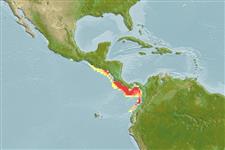Teleostei (teleosts) >
Lophiiformes (Anglerfishes) >
Linophrynidae (Leftvents)
Etymology: Acentrophryne: Greek, 'a' = without + Greek, 'kentron' = prickle or spine + Greek, 'phryne' = toad (highlighting the single most important distinguishing feature of this genus: the absence of a preopercular spine) (Ref. 86949).
More on author: Regan.
Environment: milieu / climate zone / depth range / distribution range
Ecology
Marine; bathypelagic; depth range ? - 1280 m (Ref. 86949). Deep-water
Eastern Pacific: Gulf of Panama and Costa Rica,
Size / Weight / Age
Maturity: Lm ? range ? - ? cm
Max length : 5.0 cm SL (female)
Short description
Identification keys | Morphology | Morphometrics
Dorsal soft rays (total): 3; Anal soft rays: 3. Diagnosis: Metamorphosed females of Acentrophryne longidens differ from A. dolichonema in having a much shorter distal escal appendage (2.3-2.5% SL vs. 27.6-35.7% SL); a shorter illicium (35.7-54.9% SL vs. 63.6-70.5% SL); a wider head (35.7-37.3% SL vs. 25-28.1% SL); and a greater number of pectoral fin rays (18-19 vs. 16) (Ref. 54827); caudal fin rays 9, ninth ray (ventral most) 18.6-22.6% SL (Ref. 86949).
Life cycle and mating behavior
Maturity | Reproduction | Spawning | Eggs | Fecundity | Larvae
Pietsch, T.W. and R.J. Lavenberg, 1980. A fossil ceratoid anglerfish from the Late Miocene of California. Copeia 1980(4):906-908. (Ref. 41541)
IUCN Red List Status (Ref. 130435: Version 2024-2)
Threat to humans
Harmless
Human uses
Tools
Special reports
Download XML
Internet sources
Estimates based on models
Preferred temperature (Ref.
123201): 7.2 - 11.4, mean 9.6 °C (based on 13 cells).
Phylogenetic diversity index (Ref.
82804): PD
50 = 0.7500 [Uniqueness, from 0.5 = low to 2.0 = high].
Bayesian length-weight: a=0.01995 (0.00906 - 0.04395), b=3.01 (2.83 - 3.19), in cm total length, based on all LWR estimates for this body shape (Ref.
93245).
Trophic level (Ref.
69278): 3.5 ±0.6 se; based on size and trophs of closest relatives
Fishing Vulnerability (Ref.
59153): Low vulnerability (10 of 100).
